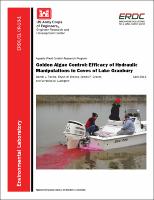Please use this identifier to cite or link to this item:
https://hdl.handle.net/11681/2900| Title: | Golden Algae control: efficacy of hydraulic manipulations in coves of Lake Granbury |
| Authors: | Aquatic Plant Control Research Program (U.S.) University of Texas at Arlington. Department of Biology Baylor University. Center for Reservoir and Aquatic Systems Research Texas A & M University. Texas AgriLife Research Roelke, Daniel L. Lundgren, Veronica M. Brooks, Bryan W. Grover, James P. |
| Keywords: | Aquatic plant control Bloom mitigation Deepwater flushing Euclidean distance measures Golden algae Harmful algal blooms (HABs) Lake Granbury, Texas Rhodamine WT Water exchange rates Aquatic Plant Control Research Program (U.S.) |
| Publisher: | Environmental Laboratory (U.S.) Engineer Research and Development Center (U.S.) |
| Series/Report no.: | ERDC/EL CR ; 13-1. |
| Description: | Contract Report Abstract: Bloom mitigation approaches employing deepwater flushing show great promise when targeting coves of Lake Granbury, USA. They may be limited, however, based on the natural water exchange rate between targeted coves and the surface waters of the open lake. This potential limitation was investigated by conducting dye-tracer studies that enabled direct measurement of water exchange rates. Historical data were also analyzed to explore the dissimilarity between coves and the open lake. Finally, a numerical model was built to estimate P. parvum bloom reduction levels under various deepwater flushing scenarios. Dye tracer studies involved time-series, high-resolution spatial mapping of Rhodamine WT in three target coves. To complement spatial mapping, vertical profiling was performed at fixed-location stations throughout these coves. These combined processes allowed researchers to calculate the total amount of Rhodamine WT over time in these coves. From this information, natural water exchange rates between coves and surface waters of the open lake could be determined, and were typically found to be in the range of ~0.25-0.30 d^-1. Analysis of historical data utilized an extensive data set comprised of biotic and abiotic parameters from 10 coves and 10 open lake stations. The data record spanned multiple years with a once-per-month sampling frequency. Dissimilarity relationships (estimated from Euclidean distance measures) between coves and the open lake with changes in winds and inflows to the lake were examined. It was found that water exchanges with coves located lower in the lake were linked to winds and inflows. Mechanisms driving water exchanges with coves higher in the lake, however, are still not clear. Proposed management scenarios were depicted with deepwaters being pumped from the open lake to the upper regions of coves. Results suggest that P. parvum blooms can effectively be mitigated in cove habitats of Lake Granbury through managed deepwater hydraulic flushing. In some scenarios, blooms were reduced by >70%. The next steps in research aimed at further developing this mitigation approach should be a coupled study involving model refinement and a valuation study. |
| Rights: | Approved for public release; distribution is unlimited. |
| URI: | http://hdl.handle.net/11681/2900 |
| Appears in Collections: | Contract Report |
Files in This Item:
| File | Description | Size | Format | |
|---|---|---|---|---|
| ERDC-EL-CR-13-1.pdf | 10.21 MB | Adobe PDF |  View/Open |